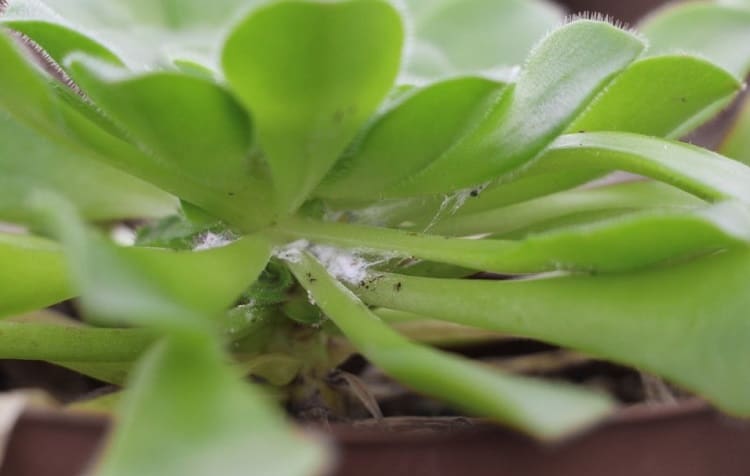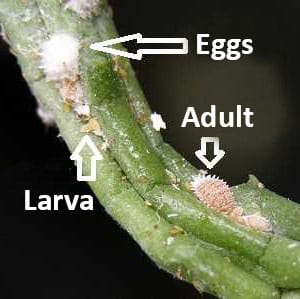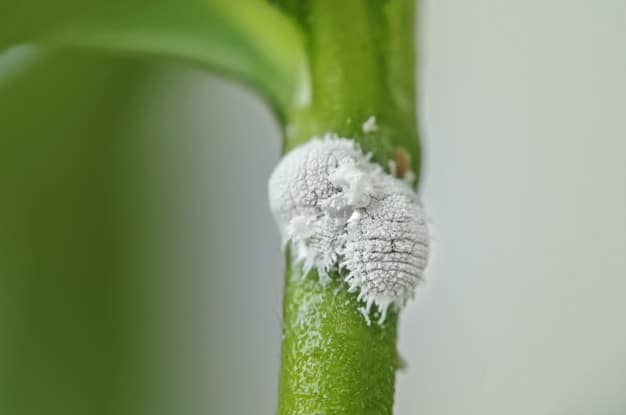Demystifying White Fuzz on Succulents: Why It Occurs and How to Tackle It
If you see white fuzz on your succulents, it means your plant is being attacked by mealybugs. In this article, we will explain what mealybugs are and why they show up on your plants. We will also guide you on how to spot them and how to get rid of them for good.

Contents
Mealybug: The White Fuzz On Succulents
When your succulent has white fuzz which is the mealybug, you need to take immediate action. To combat this bug, we will share some simple home remedies that you can use. It’s worth mentioning that these remedies not only help eliminate mealybugs from your succulents but can also be used as a preventive measure by applying them regularly to keep these bugs away.
There are over 7,500 species of mealybugs worldwide, but the cotton mealybug (Phenacoccus solenopsis) is the most well-known and commonly found one that attacks succulents and cacti.

Mealybugs are tiny insects, usually less than 4 mm long, covered in a white color. They tend to hide in the roots, under the leaves, or around the stems, making them hard to detect at first.
Among the various types of mealybugs, the cotton mealybug is the most frequent one you might encounter.
For those who are not familiar with this pest, be warned: mealybugs can become your worst enemies. If not controlled in a timely manner, they can quickly become a major problem. What’s more, mealybugs can easily move from one plant to another, spreading and infecting your entire succulent collection without you even noticing until multiple plants are affected.
These unwanted guests feed on the sap of succulents and cacti, especially targeting the newly growing parts. As they feed, they create small wounds that weaken the plants, making them more susceptible to infections and rot. This can result in scars on the leaves, giving your succulents an unsightly appearance, stunting their growth, and causing them to appear weak and unhealthy.
Negative effects of mealybugs on succulents
- Deformations in growth and callus formation: Mealybug infestations can lead to irregular growth and the formation of abnormal calluses on the succulent’s stems or leaves.
- Speedy wilting of stems and leaves: Succulent parts infested with mealybugs may start to droop, wilt, or wither more quickly than usual.
- Premature dropping of flower buds: If mealybugs attack the flower buds, they can cause them to fall off before they have a chance to bloom, robbing you of their beauty.
- Necrosis of stems and roots: The presence of mealybugs can cause necrosis, which means the affected areas of the succulent’s stems or roots would suffer tissue death.
- Virus transmission: Mealybugs can transmit viruses from one plant to another, potentially causing further damage to the health of your succulents.
- Wounds inviting bacterial or fungal infection: When mealybugs feed on the succulent’s tissues, they create wounds that can become susceptible to bacterial or fungal infections, leading to additional complications.
These negative effects of mealybugs emphasize the importance of promptly addressing and eliminating these pests to protect the well-being of your succulents.
How To Detect Mealybug In Your Succulents
One unmistakable indication of mealybugs is the presence of what appears to be “cotton” on your plants. These cotton-like clusters are not actually cotton but rather groups of eggs, showing that the mealybugs have been residing on your succulents for some time.
Did you know this?
- Females are the parasites: In this group of insects, it is the females that feed on the plant’s sap, while the males have a singular purpose, which is reproduction. The males have a short lifespan that lasts only a few days. Once the females reach adulthood, they typically remain immobile in specific areas of the plant to extract sap as their source of food.
- Protective shield: To defend themselves while being immobile, many female mealybugs have evolved a hard, waterproof shield that covers their entire body, resembling a protective scale. This shield makes it challenging to control these pests using common contact insecticides like Cypermethrin. Systemic insecticides, on the other hand, are more effective in eliminating these pests from plants.
- Fungal proliferation and ant attraction: Mealybugs can pose additional problems for plants. Most species of mealybugs produce a sugary substance that promotes the growth of pathogenic fungi. This substance also attracts ants, which then protect the mealybugs from other predatory insects.
- Wings of male mealybugs: Only male mealybugs have wings as they require them to search for females for reproduction. Females, on the other hand, do not develop wings as they do not need them for their immobile lifestyle.
These facts shed light on the intriguing characteristics and challenges associated with mealybugs concerning plants.
However, don’t worry! Mealybugs are not unbeatable. There are several effective home remedies and chemical solutions that can help you eliminate them. The speed at which you can get rid of these pests depends on how much they have spread throughout the affected plants. In other words, the sooner you detect them, the quicker you can eradicate them. Keep an eye out for any signs of mealybugs and act promptly to protect your succulents.
How To Eliminate Cotton Mealybug On Succulents

Now, we will provide you with four simple tips to help you eliminate mealybug pests from your succulents.
- Check all your plants: When you detect mealybugs on one of your plants, it’s important to examine all your other plants as well. Since these pests spread easily, it’s crucial to identify and address any affected plants to prevent further infestation.
- Look for hiding spots: Take a close look at areas where mealybugs tend to hide, such as the stems near the soil, newly grown leaves, and the undersides of leaves. These are their favorite hiding spots, so carefully inspect them for any signs of infestation.
- Quarantine affected plants: It’s essential to separate any plants with mealybugs from the rest of your collection. When you begin treatment, mealybugs might try to find new plants to infest. To protect your healthy plants, it’s best to keep the infested ones isolated until they are free from pests.
- Control watering: Mealybugs thrive in moist conditions, so it’s important to regulate the irrigation of your plants. Allow the soil to dry between waterings as this makes it more challenging for these pests to survive and reproduce.
It is common for mealybugs to appear on our plants at some point, especially if we add new plants to our collection without checking for pests. Therefore, it’s always advisable to inspect newly acquired plants, ensuring they are free from mealybugs or any other pests before integrating them with your existing plants.
Home Remedies For Cotton Mealybugs
1. Solution of isopropyl alcohol
One effective home remedy we often use to get rid of cotton mealybugs is a solution made of 70% isopropyl alcohol mixed with water. We prefer using rubbing alcohol for several reasons: it is good for the environment, easily accessible, simple to apply, and cost-effective. An added benefit is that it also helps eliminate aphids!
When using alcohol, it’s crucial to remember an important point: after application, do not expose your succulents to direct sunlight. Keep them in the shade or provide filtered light for a couple of days. It’s best to apply alcohol in the late afternoon and take advantage of cloudy or overcast days for this remedy. If your plants are indoors, this is usually not a problem.
Make sure to target the areas where the stem and leaves meet, the base of the plant, and any spot where mealybugs could be hiding. We also recommend spraying a small amount on the substrate, just in case there are hidden eggs present.
If your plants have a lot of mealybugs, applying the mixture once may not be sufficient. In such cases, you should wait for about 3 or 4 days and apply it again. The reason for this is that sometimes mealybugs come back as there may be eggs hidden in hard-to-reach areas, leading to a new infestation. It’s important to stay vigilant and reapply the alcohol mixture if needed.
Alcohol kills mealybugs upon contact and does not harm your succulents. However, please be cautious and avoid using this remedy on other plants as it may cause damage.
This method works effectively as long as you are aware of the precautions needed for your succulents. If you’re unsure about these precautions, we suggest utilizing one of the other two methods we recommend.
2. Diatomaceous earth
Another home remedy that you can use to remove the cotton mealybug from succulents is diatomaceous earth.
Diatomaceous earth is a very effective ecological insecticide against some types of pests.
3. Solution of potassium soap
Lastly, another home remedy to get rid of cotton mealybugs from your succulents is potassium soap, which can be purchased at your local supermarket, grocery store, or through this link* on Amazon.
*This is an affiliate link. As an Amazon Associate, we earn from qualifying purchases which means we receive a small commission when you make a purchase, at zero cost to you.
Similar to the previous remedies, the potassium soap solution is both eco-friendly and safe. It is biodegradable and poses no harm to people or pets. Not only does it combat cotton mealybugs, but it also works against pests like red spiders, aphids, and whiteflies.
Using this remedy is quite simple. All you need to do is mix a portion of the soap with hot water until it melts and forms a soapy solution. Afterward, you can apply it to your succulents without any issues.
